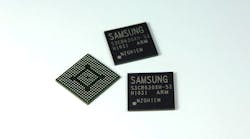Interview: Sravan Kundojjala Offers Insight on Strategy Analytics’ New Report
Sravan Kundojjala is the author of Strategy Analytics’ report, LTE, 64-bit and Semiconductor Technologies to Lift Smartphone Apps Processor Market to $30 Bn in 2018.Kundojjala was able to disclose some of the important information regarding the smartphone-applications-processor market between now and 2018. That market is expected to grow at a CAGR of 10.8%—reaching $30 billion in 2018. Additionally, the report details the cause of this shift and how standalone applications differ from those controlled by vendors when it comes to market penetration.
SM: How will LTE-Advanced (LTE-A), 64-bit, multicore, and semiconductor process technologies boost the smartphone-applications-processor market?
SK: The assumption here is that these new technologies--including LTE-A, 64-bit, 4K, sensors, and FinFET semiconductor process technologies--will enable new apps and will kick off a new upgrade wave. Previously, we have seen this happening with 3G, dual-core, quad-core, and other technologies. So, the basic idea here is that any new technology that can make things better is likely to catch market attention and thus serve as a growth engine for application-processor (AP) players.
SM: The report states that standalone applications-processor penetration in smartphones will drop to 28% in 2018 (down from 38% in 2012). What percent of the market is being controlled by vendors such as Qualcomm, MediaTek, Spreadtrum, Broadcom, and Marvell? And what are they doing to keep others out?
SK: Baseband-integrated chips are currently popular in mid-to-low-tier smartphones and are increasingly gaining traction in the high end. Baseband-integrated chips offer bill-of-material (BoM) cost advantages and take up less circuit-board space compared to standalone chips. Standalone chips are currently popular in premium smartphones. Qualcomm, MediaTek, Spreadtrum, Broadcom, and Marvell are driving the integration trend in smartphone APs. Standalone AP chips have time-to-market advantages over integrated APs in terms of new feature introduction, as AP features tend to progress slightly faster than modem features. As a result, premium-tier smartphone vendors opt for standalone chips to bring the latest and greatest features. Integrated vendors will take some time to close the initial time-to-market gap. We forecast that baseband-integrated AP vendors, such as Qualcomm, MediaTek, Spreadtrum, Broadcom, and others, will increase their share from 62% in 2012 to 72% in 2018.
SM: What is driving the growth of 64-bit chip penetration in smartphone application processors? It is reported to rise from 3% to 75% by 2018.
SK: Apple surprised the industry with the industry‘s first 64-bit smartphone/tablet chip in 2013. Apple has a 9- to 12-month advantage versus competition in this aspect. Android and other non-iOS mobile platforms are not yet optimized for 64-bit chips. We expect Android to gain 64-bit support this year, which will help 64-bit chip adoption in smartphones.
We believe the need for higher DRAM and PC-like app performance will drive 64-bit chip adoption in smartphones and tablets. However, we feel that this adoption will be somewhat slower than multicore technologies, as the software and app ecosystem is likely to take time.
SM: Why will the required software ecosystem transition for 64-bit chip adoption take longer than it did for multicore chip adoption in smartphones?
SK: This is primarily because 32-bit chips will still provide sufficient performance in 2018. As a result, some OEMs and chip vendors may not feel the burning need to completely upgrade their portfolios to 64-bit chips. This could potentially slow down the 64-bit chip adoption in smartphones.
SM: Why is Intel focusing efforts to limit ARM-based chip penetration in smartphones? (Reportedly, such penetration is down to 83% in 2018 compared to almost 100% in 2012.)
SK: We expect Intel’s upcoming SoFIA 3G/4G integrated chips to gain significant traction in smartphones. This will help Intel gain some much-needed volume share in smartphones. In addition, Intel’s 14-nm-based FinFET products will help. Intel is aggressively attacking the white-box Android tablet market and this could result in share gains. Intel is one of the very few players with commercial LTE technology. The company is likely to leverage this to survive industry consolidation.
SM: Is there anything else you'd like to share with our audience about this report?
SK: Overall, I would say the smartphone and tablet AP markets are primed for double-digit growth over the next five years. This will create an enormous opportunity for AP vendors while forcing some players to merge with each other or exit the market altogether. There are interesting times ahead.
